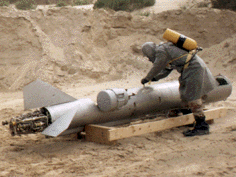
Back Ch-28 Czech Ch-28 German Kh-28 French Kh-28 ID Kh-28 Italian Ch-28 Polish Х-28 Russian Raduga Ch-28 Swedish Х-28 Ukrainian Raduga Kh-28 Vietnamese
| Kh-28 (NATO reporting name: AS-9 'Kyle') | |
|---|---|
 USAF EOD specialist disassembles presumed Kh-28 – Iraq 1991 | |
| Type | air-launched anti-radiation missile |
| Place of origin | Soviet Union |
| Service history | |
| In service | 1973–current |
| Used by | FSU,[1] Warsaw Pact,[1] India,[1] Iraq,[1] Vietnam[1] |
| Production history | |
| Designer | Alexander Yakovlevich Bereznyak |
| Manufacturer | MKB Raduga |
| Specifications | |
| Mass | 720 kg (1,590 lb)[2] |
| Length | 597 cm (19 ft 7 in)[2] |
| Diameter | 43 cm (16.9 in)[2] |
| Wingspan | 193 cm (6 ft 4.0 in)[2] |
| Warhead | Blast fragmentation[1] |
| Warhead weight | 160 kg (353 lb)[2] |
| Engine | Two-stage liquid-fuel rocket[2] |
Operational range | 110 km (59 nmi) [3] |
| Maximum speed | Mach 3.0[2] |
Guidance system | Inertial guidance with passive radar seeker[1] |
Launch platform | Su-17M/Su-20/Su-22M, Su-24M, Tu-16, MiG-25BM, MiG-27, Tu-22M[4] |

The Kh-28 (Russian: Х-28; Nisan-28; NATO: AS-9 'Kyle') was the first Soviet anti-radiation missile (ARM) for tactical aircraft.[1] It entered production in 1973 and is still carried on some Sukhoi Su-22s in developing countries but is no longer in Russian service.[1] Use of the Kh-28 was restricted by its weight, limited seeker head, bulk and fuelling requirements, and it was superseded by the smaller, solid-fuel Kh-58 (AS-11 'Kilter') in the early 1980s.
- ^ a b c d e f g h i Cite error: The named reference
IECHwas invoked but never defined (see the help page). - ^ a b c d e f g Cite error: The named reference
NIGWNWSwas invoked but never defined (see the help page). - ^ Cite error: The named reference
Crimsonwas invoked but never defined (see the help page). - ^ Cite error: The named reference
JALWwas invoked but never defined (see the help page).